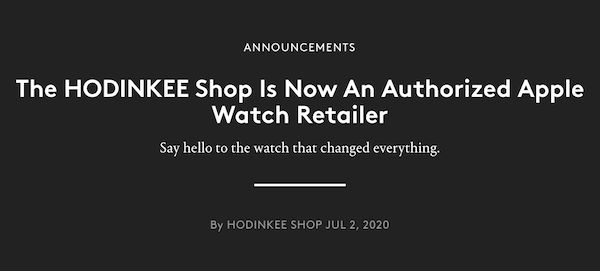
Watch website Hodinkee’s announcement that they’re going to carry the Apple Watch in their store was met with befuddlement here at TTAW Global HQ. The brand calling itself “the preeminent resource for modern and vintage wristwatch enthusiasts” should be embarrassed for carrying the thing that every single yutz at the local Pinkberry is wearing. Which raises an important question: why is the watch press so bad?
To be fair, fake journalism, bad journalism, and suborned journalism is common across most industries. I come from the tech world, where the press is famously supine. The publications are staffed by “journalists” whose sole goal is to gain experience and build contacts before working for “real money” at the companies they covered.
If a “writer” at Venturebeat, Techcrunch, etc. shows themself to be a useful-enough idiot, they can sashay straight into a cushy gig in corporate communications at double or triple their relatively meagre journalistic pay. Given that corporate comms requires employees to have a tangential relationship with the truth (at best), living up to the ideals of J-school would be counterproductive.

If you’re a real shill you can grab the brass ring: a job in venture capital. Regardless, the tech press is a finishing school for people that have no actual useful skills besides basic literacy and their ability to network. And lie.
That’s why every single tech scandal – from backdating to Juicero to Theranos to Wirecard has been exposed by journalists outside of a tech publication. The financial press’ readers – investors – are willing to pay for the truth.
If you want to understand why watch industry journalists are lap dogs it’s because they work in a culture that rewards those who operate according to an unspoken agreement: don’t rock the boat.
Access Equals Money

Hodinkee is both a publication and eCommerce site. The watch website lives or dies according to their access to manufacturers’ products – both for the latest, greatest watch and hideous versions of basic-bitch pieces.
For their online store to survive, Hodinkee must stay in the manufacturers’ good graces. To project a veneer of credibility, Hodinkee must have editorial access to the latest watches. In short, their business rests on the bedrock of maintaining their status as the industry’s number one sub.
Hodinkee’s editorial and shop teams may “produce their content independently,” but both parts of the biz dance to the same tune. Which is why HoDinkee will never, ever say anything bad about watchmakers or their products.
What about the rest of the rag tag members of the horological press? Aside from news sites like WatchPro.com – a paper tiger for much the same reason – there are two other types of watch websites, best categorized by their revenues streams.
Watch Websites Selling Watches and Accessories

A number of watch sites make their living on the sale of accessories and watch related items. Some of these sales sites are “journalistic” with a watch and watch accessory business attached. Others are retailers with a bit of journalism for customer acquisition. In either case, controversy does not sell.
To get readers to become eCommerce customers, these sites need to make them feel comfortable spending money. Making waves with the industry or challenging your readers is not conducive to selling goods. Have you ever said “I disagree violently with what they’re saying, but I love their merch”?
Watch Websites Selling Advertising

There are two types of advertising for a watch website: display advertising and partnerships.
Display ads are generally algorithmic, targeted at a particular audience. Advertisers buy customer demographics, number of hits/clicks, and engagement with the site (generally measured as dwell time).
Programmatic advertisers want users who spend a long time reading and clicking on other articles. The best way for a watch website to encourage readers to linger: publish agreeable content. No confrontations with reality. No reasons to click away.

Partnerships are the second major type of advertising: site takeovers, joint events or other co-branded deals.
Partnerships require a significant investment of time and effort. A salesforce sells a major brand on the quality of the site’s audience. The brands look for audience demographics and engagement metrics and, crucially, whether or not the site “aligns with our views.”
Show me an ad sales guy who says “sure, go ahead and attack the flagship product of my best client,” and I will . . . it doesn’t matter because it never happens.

These two factors – pursuing the maximum audience and depending on brands for revenue – contribute to the milquetoast mediocrity of so many watch websites. Combine this with an industry whose economics are currently under “revision” and the watch websites are under profound pressure to toe the line.
This of course makes all the watch websites very much alike. If you’re the same as everyone else, how do you get the audience numbers in the first place? In part 2, I’ll drill down on how watch websites bank big bucks. How their methodology shows utter contempt for you, the reader.
Click here to read Watch Websites’ Mediocrity – Part Two
an insightful and thought provoking article. thank you guys. hodinkee flogging apple watches. seriously. they were barely credible before that (for some time too) and now its utterly contemptuous. a line of casio illuminators might have been acceptable however, a cheap piece of total rubbish for several hundred big ones. total evil. anywho each to their own of course. keep up the great work here guys. its refreshing and on the money.
Thanks for the kind words, and thanks for reading!
web sitesi teklifi
Şanlıurfa Uyducu olarak uydu çanak anten arızalarınızda bir telefon uzağınızdayız.